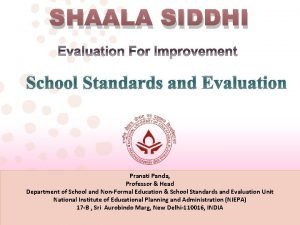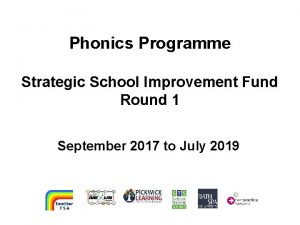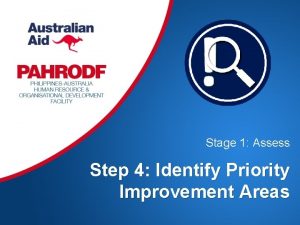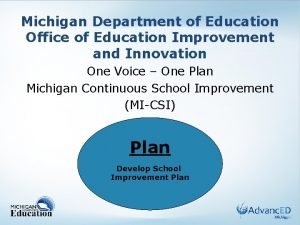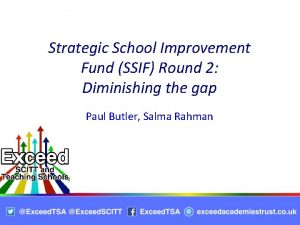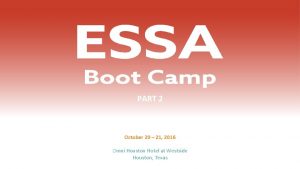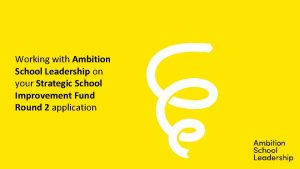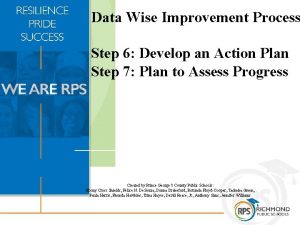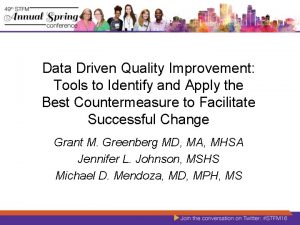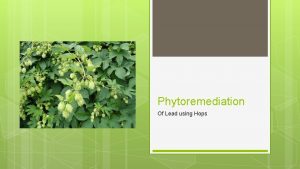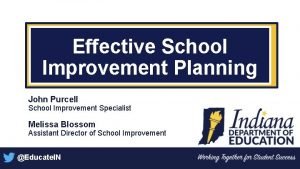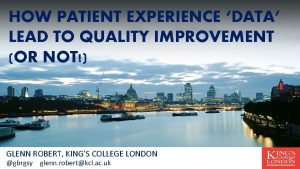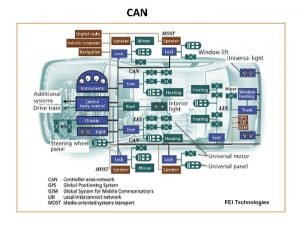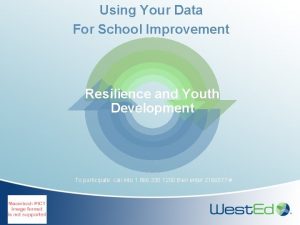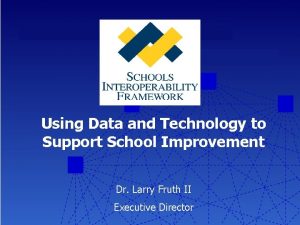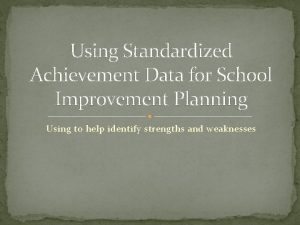How Can Using Data Lead to School Improvement
















- Slides: 16

How Can Using Data Lead to School Improvement?

Six-Year Plan: Vision Collaborating for Success VISION: 1. 2. An effective positive behavior support system fosters discipline at each school. All teachers and administrators participate in fully functioning professional learning communities. Purposeful Use of Data &Assessment High Quality Curriculum &Instruction VISION: 1. All students achieve high levels of success as math problem solvers. 2. All students achieve high levels of success as readers, writers and thinkers. 3. All subgroups of students meet or exceed Standards of Learning goals. 4. All students graduate from high school. 5. All teachers reflect on student learning and continuously work to improve instructional practices. Community Outreach VISION: 1. Teachers and schools respond intentionally when 1. All Staunton City Schools are revered by staff, students struggle with or exceed learning expectations. students, parents, and community. 2. All staff collect, manage, and use data and assessment 2. All Staunton City School parents are fully involved to inform decisions. and engaged in their child’s education.

What data do you collect? Assessment Data (Quantitative) Perception Data (Qualitative) Student Data (Quantitative) Program Data (Quantitative)

Why do you choose to keep that data? Assessment Data Student Data Where do we as a department or school want to be? What are the needs? Is this reflected in our goals? Is what we are doing making a difference for ALL students? What are the highest accomplishments we can achieve in our department/ school/ division? Are we there? Are all students meeting the benchmark? Are all students making progress? Perception Data Program Data How do we want to be perceived by students, parents, staff, community? Is what we are doing working? Is that the perception? If so, how can we continue to show improvements in this area? If not, have we implemented with fidelity? What do we need to do in order to see progress?

� Schools committed to improving student learning need information more than ever. They must have a process that gathers authentic and relevant information and used it to identify strengths and weaknesses in a way that pushes people toward continuous improvement. ” (Dolan, 1994)

Where should we focus our attention? Goal-Setting Daily Instruction It takes all of us. . . Goals AND Strategies Every day matters. . . üAdministrator s üTeachers üStaff üStudents üParents üCommunity üMaximized instructional time üClearning target (planned) üAligned curriculum üEngaged/authentic üHigher-level thinking (rigor) üEvidence of student learning Work of the PLCs Intervention Common learning goals, assessments, reflections Continuous monitoring and support for individual student progress üWhat do we want students to know? üHow will we know they have learned it? üHow will we respond when they don’t learn it? üHow will we enrich when they do learn it? üUse data to identify students üSet appropriate goals for students üProvide high-quality intervention and support üContinuously monitor student progress

How does data lead to improvement? Questions to begin thinking about soon. . . � Did we, as a school/division, meet our objectives? � If not, what do we need to do differently? What are indicators (best practices) that align to our data needs? � What is the climate of our school/division? What are some specific perceptions or needs that need to be addressed in the improvement plan? � What programs and/or interventions are working or not working?

Resources for School Improvement

What does the data indicate is an area of improvement? Math? Reading? Graduation? Subgroup? Discipline? Attendance? Content category?

What are contributing school factors or needs? Common vision? High level thinking? Belief in all students? Rigorous assessments? Aligned curriculum? Fidelity of implementation? Maximized instructional time? Specific and targeted interventions?

How do these needs align with indicators? Example Data/ Need: Data indicates that the mathematics performance at the school was significantly lower than other schools implementing the same curriculum. Indicator ID 10: The school’s Leadership Team regularly looks at school performance data and aggregated classroom observation data and uses that data to Was the curriculum implemented make decisions about school with fidelity? How will we know if we improvement and professional are making improvements in this development needs. area?

Required Improvement Indicators for All Schools in Improvement School leadership teams must assess and include three targeted interventions indicators below in their improvement plans. Targeted Interventions The school uses an identification process (including ongoing conversations with instructional TA 01 leadership teams and data points to be used) for all students at risk of failing or in need of targeted interventions. The school uses a tiered, differentiated intervention process to assign research-based interventions aligned with the individual needs of identified students (the process includes a TA 02 description of how interventions are selected and assigned to students as well as the frequency and duration of interventions for Tier 2 and Tier 3 students). The school uses a monitoring process (including a multidisciplinary team that meets regularly to review student intervention outcome data and identifies “triggers” and next steps for TA 03 unsuccessful interventions) for targeted intervention students to ensure fidelity and effectiveness.

How does data lead to improvement? Questions to consider throughout the year. . . � Based on universal screenings and other assessments, are all students showing growth? � Who are students being monitored? Tier 2 students? Tier 3 students? What is being done for these students, and is it making a difference? � What instructional trends is our walk-through data showing and where do we need to focus attention? � Does our data correlate? For example, do our grades align with our other assessments? � What does the work of the PLC look like? Does it demonstrate academic rigor? What are the key elements? � Is behavior getting in the way of learning? If so, for whom? How? � Is attendance getting in the way of learning? If so, for whom? How? � Are we on track for meeting/ exceeding benchmarks? How do we know?

The right data is predictive. . .

Drum Roll Please. . .

“How High-Poverty Schools are Getting it Done” � 1 – Their beliefs about potential drive their work. � 2 – They put instruction at the center of their managerial duties. � 3 – They focus on building the capacity of all the adults in the building. � 4 – The monitor and evaluate what leads to success and what can be learned from failure.
 Lead magnesium niobate
Lead magnesium niobate Shaala siddhi dashboard
Shaala siddhi dashboard Annual implementation plan
Annual implementation plan Strategic school improvement fund round 3
Strategic school improvement fund round 3 Identifying priority improvement areas
Identifying priority improvement areas School improvement plan michigan
School improvement plan michigan Strategic school improvement fund round 3
Strategic school improvement fund round 3 School improvement plan
School improvement plan Swot analysis for school
Swot analysis for school Strategic school improvement fund round 3
Strategic school improvement fund round 3 Data wise steps
Data wise steps Data driven quality improvement
Data driven quality improvement How can anger and revenge lead to fights?
How can anger and revenge lead to fights? Common factors that can lead to food poisoning
Common factors that can lead to food poisoning Using system using system.collections.generic
Using system using system.collections.generic Accumulator ac
Accumulator ac How can using refusal skills help you to avoid stress
How can using refusal skills help you to avoid stress

